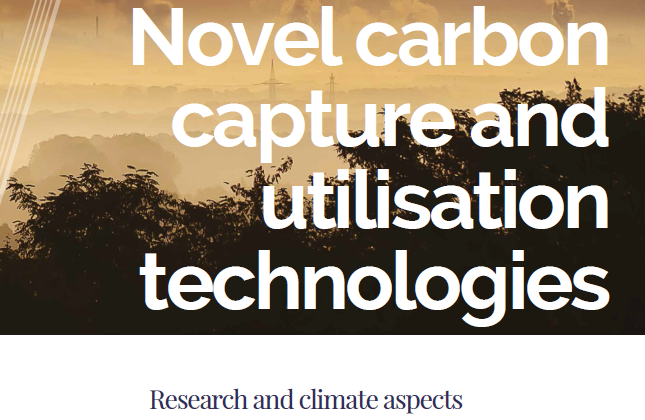Novel carbon capture and utilisation technologies
Research and climate aspects
SAPEA Evidence Review Report No. 2
Informs the European Commission Group of Chief Scientific Advisors Scientific Opinion No. 4/2018
This report aims, within the framework provided by the SAM/HLG Scoping Paper, to assess the climate mitigation potential of Carbon Capture and Utilisation (CCU), which is defined as “those technologies that use CO2 as a feedstock and convert it into value-added products such as fuels, chemicals or building materials”.
From a system perspective, CCU involves a number of steps, from capture of CO2 to its conversion into usable C-rich products, from the use of such products to their disposal as C-rich waste, and ultimately, CO2 re-emission – which may happen shortly after CO2 conversion (e.g. for synthetic fuels), or much later (e.g. for polymers). To power the CO2 capture and transformation processes and – in most cases – the synthesis of green-hydrogen as a co-reactant, C-free energy is needed. These processes consist of building blocks that also belong to other technology chains of interest for climate mitigation. As a consequence, CCU’s climate mitigation potential needs to be assessed from a systems perspective, and with regards to how it can provide societal services. These are defined here as (i) power generation and distribution through the grid, (ii) fuels (and power) for transport and mobility, (iii) long-term storage and long-range transport of intermittent renewable energies; and (iv) manufacturing of industrial products.
The report offers a simplified system analysis of service delivery, which highlights a few key features. 1) Using C-rich synthetic fuels requires the use of large amounts of Renewable Energy Sources (RES) and other carbon-free energies – much larger than what is required when RES electricity or green-hydrogen is used directly for consumption. 2) Such a decrease in efficiency in the use of RES may be acceptable in the provision of: a) C-rich synthetic fuels to power long-range aircraft and long-haul ships; and/or b) long-term storage and long-range transport of defossilised energy to compensate for the intermittency of RES. 3) For such uses, CCU-based solutions should be assessed in comparison with other alternative technologies that are beyond the scope of this report.
To consider the potential opportunities offered by CCU to European industries in supporting (i) climate change objectives, (ii) a circular economy, (iii) energy security and deployment of RES; and (iv) the evolution of CO2 capture systems, the report has defined an assessment framework. Such a framework identifies nine technology chains with respect to the generation and use of C-rich fuels and classifies them (according to a few first-order simplifying assumptions), based on whether they generate positive, net-zero, or negative CO2 emissions.
From the analysis of these technology chains, some key conclusions can be drawn: CCU may be part of a circular economy scheme where carbon atoms are recycled and re-used indefinitely over a long time scale. However, it is neither an indispensable element, nor is it sufficient, for a circular economy. True circular schemes are enabled only when the CO2 generated from burning recycled synthetic (defossilised) fuel in centralised plants or in distributed facilities is again captured from the flue gas (post-combustion capture) or from the ambient atmosphere (direct air capture). CCU is not part of any negative emission technology chain, whereas CO2 capture is; the pros and cons of using biomass instead of fossil-C or of converted CO2 can be highlighted in the context of this analysis. Such analysis can also offer clear guidelines for a methodology that enables the assessment of the opportunities ((i) to (iv) above) emerging from the introduction of a set of new technology solutions, and which should be preliminary to a full Life-Cycle Assessment (LCA).
The report identifies a need for innovation in at least three domains. Firstly, from a policy perspective: measures, regulations and incentives should examine the energy system – including CCU – in a holistic, integrated, coordinated and transparent manner.
Secondly, from a systemic perspective: such an approach is required when evaluating the energy system and its CCU sub-systems; further development is needed here, both in terms of stakeholder awareness and of consistent definitions of system boundaries and of reference datasets.
Finally, from a technology perspective: key technical challenges must be tackled in the areas of: collection and purification of CO2 from different sources, synthesis of green-hydrogen via water splitting powered by RES, and catalytic technologies for reductive activation for CO2 conversion to fuels and chemicals. The report concludes by providing a few recommendations for action, inspired by the analysis and considerations above.
https://www.sapea.info/wp-content/uploads/CCU-report-web-version.pdf


The comment area